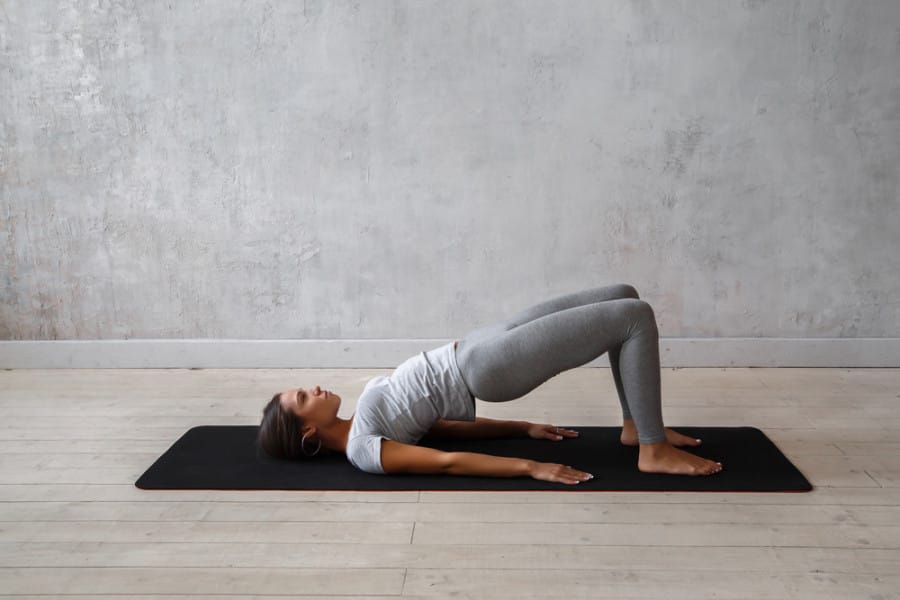‘How To Perfectly Do A Bridge Pose In Yoga
Bridge pose in yoga, also known by its Sanskrit name setu bandha sarvangasana, is a fundamental position in most yoga practices. It is accessible to beginners while still offering a challenge to advanced practitioners. Not only does this pose help strengthen the core, but it also provides significant benefits for flexibility and back health.
“Bridge pose is a comprehensive exercise for core strength,” explains Esther Yaniv, MD, E-RYT 200, a physical medicine and rehabilitation physician, and a registered yoga teacher. “It engages deep postural muscles, particularly the multifidus muscles, which are crucial for supporting the spine.” The multifidus muscles are deep stabilizing muscles that run along both sides of the spinal column.
This guide will explore the essence of bridge pose, demonstrating how to perform the pose with elegance and strength.
Benefits of Bridge Pose
Bridge pose, or setu bandha sarvangasana, offers a wide array of benefits that span the physical, mental, and emotional aspects of well-being.
Primarily, it enhances spinal flexibility and opens up the chest and heart area, leading to improved posture and respiratory function. Additionally, it strengthens the back, glutes, and hamstrings while potentially aiding in better digestion by stimulating the abdominal organs.
However, while the benefits are plentiful, improper execution of bridge pose can lead to strain on the neck and back. Incorrect technique may also put unnecessary pressure on the knees and shoulders. It is vital to engage the core throughout the pose to support the lower back and prevent the knees from spreading outward.
Physical Benefits: Strength, Flexibility, and Back Health
- Core Strength: Bridge pose is a key player in enhancing core strength, a crucial element in yoga practice. Strengthening the core muscles through this pose establishes a solid foundation for overall body stability and strength.
- Spinal Flexibility and Chest Opening: Regular practice of bridge pose can significantly improve spinal flexibility. As you lift and extend in the pose, it also stretches the chest and shoulders, counteracting the effects of prolonged sitting or forward bending.
- Alleviating Backaches: Bridge pose can provide relief for individuals experiencing back pain. Dr. Yaniv notes, “Bridge pose activates and strengthens the multifidus muscles, supporting the spinal column and promoting back health.” It gently strengthens the back muscles, aiding in reducing discomfort and enhancing posture.
Mental Benefits: Relaxation and Focus Sanctuary
- Stress Relief and Relaxation: In today’s fast-paced world, stress relief is essential. Practicing yoga promotes relaxation and helps reduce stress and anxiety symptoms.
- Enhanced Focus and Mindfulness: Maintaining bridge pose requires concentration and mindfulness. Developing this mental discipline on the yoga mat can translate into improved focus and clarity in daily life.
Incorporating bridge pose into your yoga routine has multifaceted benefits, from strengthening your core to providing a moment of mental tranquility. It is a posture that encapsulates the essence of a well-rounded yoga practice.
How to Perform Bridge Pose, Step by Step
To master bridge pose (setu bandha sarvangasana), it is important to understand and execute each step with precision and mindfulness. Here is a concise guide to help you achieve this empowering pose.
- Begin by lying on your back on a comfortable yoga mat.
- Bend your knees and place your feet hip-width apart on the floor, ensuring they are close enough for your fingertips to lightly touch your heels when extending your arms fully.
- Press into your feet and arms firmly to establish a stable base.
- Engage your core muscles and lift your hips toward the ceiling, creating a straight line from shoulders to knees. Keep your thighs and feet parallel to prevent inward or outward movement.
- For added depth, clasp your hands underneath your back. Press down with your arms to raise your hips higher, ensuring your knees remain directly over your ankles without spreading outward.
- Maintain a neutral spine (the natural curve of your spine) to avoid straining your lower back by over-arching. Simultaneously, engage your core to support this alignment.
- Relax your neck and avoid straining it by excessively lifting your chest.
Key Alignment Cues for Proper Form
- Neutral Spine: Avoid overextending the lower back. Engage your core to maintain a neutral spine.
- Parallel Thighs: Keep your thighs parallel to prevent outward knee splaying.
- Relaxed Neck: Maintain a relaxed neck and prevent strain by lifting your chest excessively. Dr. Yaniv advises, “Avoid tucking your chin to the chest or lifting your hips excessively.”
Duration of Holding Bridge Pose
The ideal duration for holding bridge pose varies depending on your skill level and comfort. Typically, holding the pose for 30 seconds to one minute is beneficial. Counting breaths can be helpful, aiming for five to 10 breath cycles. It is crucial to listen to your body and not push yourself too hard, especially when learning the pose.
Optimal Timing for Practicing Bridge Pose
Bridge pose can be incorporated at the beginning or end of a yoga session. At the start, it serves as an excellent warm-up for the spine and chest. Toward the end, it functions as a calming, restorative pose to conclude the practice.
Integrating Bridge Pose into Your Yoga Routine
Integrating bridge pose into your yoga routine can be tailored to your practice’s focus. Include it in the core or middle part of your routine for strength and flexibility goals. For relaxation and stress relief, incorporate it at the end of your session. Remember, bridge pose is adaptable and can seamlessly fit into various stages of your practice, offering distinct advantages at each phase.
Variations of Bridge Pose
Bridge pose offers multiple variations to cater to different abilities and physical requirements. These variations not only diversify your yoga practice but also target various muscle groups and address different health concerns. Dr. Yaniv emphasizes the importance of adapting the pose as needed, using props like blocks or straps to support your practice and maximize its benefits.
Gentle Bridge
Ideal for beginners or individuals with back concerns, this variation involves a slight lift of the hips while keeping the back relatively flat. A yoga block can be utilized under the sacrum for additional support.
Restorative Bridge
This version requires lying on your back with a yoga block under the sacrum and a strap around the thighs for support. It provides a relaxing and nurturing experience, suitable for beginners, individuals with back problems, or anyone looking to de-stress or enhance sleep.
Single-leg bridge
To increase the challenge, raise one leg toward the ceiling while in the bridge pose. This variation intensifies the workout, particularly targeting the glutes and hamstrings of the supporting leg. Remember to switch sides midway through your breath cycles.
Bridge with chest expansion
If you can’t clasp your hands together beneath you, use a strap between your hands to open up the chest more. This modification is excellent for enhancing shoulder flexibility.
Full wheel pose
In a more advanced version, practitioners place their hands next to their head and lift into a full backbend. This should only be tried by those with adequate back flexibility and strength.
If you practice Pilates, you might wonder: How does the bridge pose in yoga differ from the bridge in Pilates?
In yoga, the bridge pose focuses on opening the chest, improving spinal flexibility, and promoting relaxation and mental calmness. In contrast, bridges in Pilates concentrate on core strengthening, particularly targeting the abdominal muscles, glutes, and hamstrings, with more emphasis on pelvic stability and alignment. While both practices involve lifting the hips off the ground, yoga often holds the pose for longer durations for stretching and relaxation, while Pilates uses dynamic movements for muscle activation and strength building.
Modifications for bridge pose
Customizing the bridge pose ensures it is accessible and challenging for all practitioners. Here are essential modifications for different needs:
For neck discomfort
- Cushioning: Place a folded blanket or cushion under the shoulders to align the neck and reduce strain.
- Positioning: Keep the neck long and avoid turning the head to the side.
- Gentle approach: Focus on a comfortable lift height without overextending the neck.
For beginners
- Support with a yoga block: Place a yoga block under the sacrum for support, adjusting the height as needed.
- Alignment focus: Maintain knee and foot alignment, ensuring a strong and stable foundation.
For an additional challenge
- Stability ball: Use a stability ball under your feet to engage more core muscles and improve balance.
- Dynamic leg movements: Try lifting one foot off the ball or extending a leg upwards to increase the intensity of the pose.
- Incremental progress: Begin with shorter durations and gradually increase as strength and balance improve.
Common mistakes people make in bridge pose (and how to avoid them)
Awareness of common mistakes in bridge pose can significantly enhance its benefits and prevent injuries.
- Collapsing knees: It’s common to let the knees splay outwards, which can strain the knees and lower back. Focus on keeping the knees hip-width apart and parallel to each other.
- Overarching the lower back: Overextending the lower back can lead to discomfort and strain. Maintain a neutral spine by engaging your core and glutes.
- Forcing the hips too high: According to Dr. Yaniv, pushing the hips up too high can be “jarring to the lower spine segments.” Instead, she recommends “softening the hip creases while squeezing the glutes as the hips leave the ground.”
- Neglecting the neck: Putting too much pressure on the neck is a common mistake. Ensure your neck remains relaxed, and most of the weight is supported by your shoulders and upper back.
- Rushing the pose: Moving too quickly into and out of the bridge pose can cause muscle strain. Enter and exit the pose slowly and with control.
- Ignoring breath: Breathing is crucial in yoga, especially in bridge pose where some people tend to compress the throat. Yani recommends inhaling on the way up, holding the pose for two to three breaths, and exhaling on the release. Connecting breath with movement is where the essence of yoga lies.














